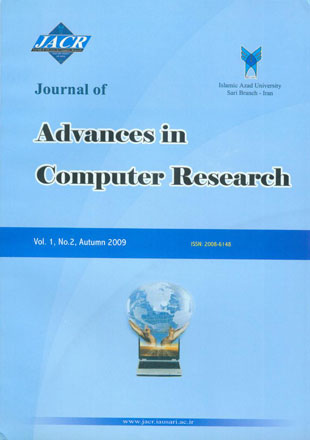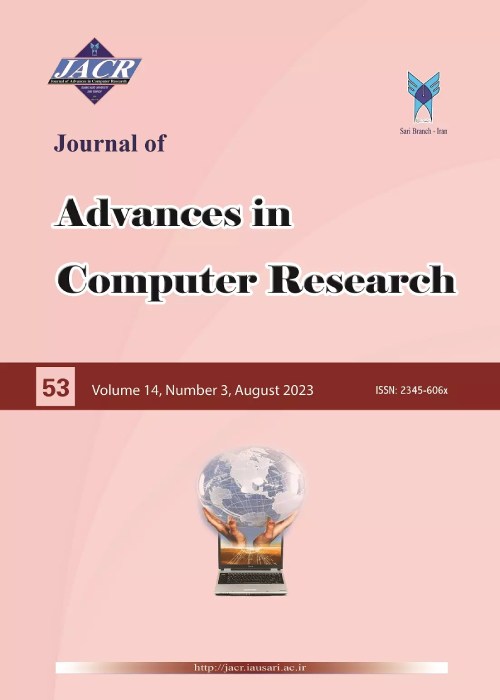فهرست مطالب

Journal of Advances in Computer Research
Volume:1 Issue: 2, Autumn 2010
- 84 صفحه،
- تاریخ انتشار: 1390/04/20
- تعداد عناوین: 8
-
Pages 1-7Service Oriented Architecture (SOA) technology enables composition of large and complex computational units out of the available atomic services. Implementation of SOA brings about challenges which include service discovery, service interaction, service composition, robustness, quality of service, security, etc. These challenges are mainly due to the dynamic nature of SOA. SOA may often need to dynamically organizing (and re-organizing) its topologies of interactions between the services due to unpredictable events, such as crashes or network problems, which will cause service unavailability. The complexity and dynamism of the current global network system require architecture that capable of autonomously changing its structure and functionality to meet dynamic changes in the requirements and environment with little human intervention. In this paper, we elaborate the idea of adapting the autonomic computing paradigm into SOA in order to meet those challenges, and we present a case study of the idea in computational engineering framework.
-
Pages 9-20The Infomax algorithm is a popular method in blind source separation problem. In this article an extension of the Infomax algorithm is proposed that is able to separate mixed signals with any sub- or super-Gaussian distributions. This ability is the results of using two different nonlinear functions and new coefficients in the learning rule. In this paper we show how we can use the distribution of observation vectors for selecting suitable coefficients for our algorithm. Hence, the proposed algorithm is suitable for real applications in which the distribution of source signals might be unknown. It is also shown in this paper that the extended Infomax algorithm is able to separate 23 sources with a variety of distributions. Incidentally, we use a performance criterion for the evaluation of our results, based on the comparison of Kurtosis of the original signals and estimated signals.
-
Pages 21-30With the rapid emergence of 3D applications and virtual environments in computer systems; the need for a new type of interaction device arises. This is because the traditional devices such as mouse, keyboard, and joystick become inefficient and cumbersome within these virtual environments. In other words, evolution of user interfaces shapes the change in the Human-Computer Interaction (HCI). Intuitive and naturalness characteristics of “Hand Gestures” in the HCI have been the driving force and motivation to develop an interaction device which can replace current unwieldy tools. A survey on the methods of analyzing, modeling and recognizing hand gestures in the context of the HCI is provided in this paper. Taxonomy of the different algorithms based on the applications that they have been developed for and the approaches that they have used to represent gestures is presented. In addition, direction of future developments is discussed.
-
Pages 31-39The first spoken dialogue system developed for the Persian language is introduced. This is a ticket reservation system with Persian ASR and NLU modules. The focus of the paper is on learning the dialogue management module. In this work, real on-line training data are used during the learning process. For on-line learning, the effect of the variations of discount factor () on the learning speed is investigated as the second contribution of the research. The optimal values for were found and the variation pattern of the action-value function (Q) in the learning process was obtained. A probabilistic policy for selecting actions is used in this work for the first time instead of greedy policies employed in previous works
-
Pages 41-53Development and usage of online social networking web sites are growing rapidly. Millions members of these web sites publicly articulate mutual «friendship» relations and share user-created contents, such as photos, videos, files, and blogs. The advances in web designing technology and fast growing usage of online resources prompted web designers to improve features and architectures of social web sites. This paper, with the experience of the authors in developing the Iranian Experts Social Network containing above 120, 000 official members, describes the features of Social Web Sites (SWSs) and proposes a taxonomy and comprehensive definition in designing such social networking tools. We then present different SWS architectures and also introduce some useful tools for social network analysis.
-
Pages 55-61The problem of eye detection in face images is very important for a large number of applications ranging from face recognition to gaze tracking. In this paper we propose a new algorithm for eyes detection. First, the face region is extracted from the image by skin-color information. Second, horizontal projection in image is used to approximate region of the eye be obtained. At last, the eye center is located by a corner detection algorithm. Part of the FACE94 Database has been used for experiments and benchmarking. Experimental results show that a correct eye detection rate of 94% can be achieved on 300 FACE94 images with different facial expressions and lighting conditions.
-
Pages 63-74In this paper the design and implementation of fault tolerable architecture for scientific workflow engines is presented. The engines are assumed to be implemented as composite web services. Current architectures for workflow engines do not make any considerations for substituting faulty web services with correct ones at run time. The difficulty is to rollback the execution state of the workflow engine to its state before the invocation of the faulty web service. To achieve this, three components for fault diagnosis, recording the execution state of the workflow and substitution of faulty web services, at run time, are considered in our proposed architecture. The applicability of the proposed architecture is practically evaluated by applying it to design of three different scientific workflow engines.
-
Pages 75-82In this paper a wavelet-based logo watermarking scheme is presented. The logo watermark is embedded into all sub-blocks of the LLn sub-band of the transformed host image, using quantization technique. Extracted logos from all sub-blocks are merged to make the extracted watermark from distorted watermarked image. Knowing the quantization step-size, dimensions of logo and the level of wavelet transform, the watermark is extracted, without any need to have access to the original image.Robustness of the proposed algorithm was tested against the following attacks: JPEG2000 and old JPEG compression, adding salt and pepper noise, median filtering, rotating, cropping and scaling. The promising experimental results are reported and discussed.


